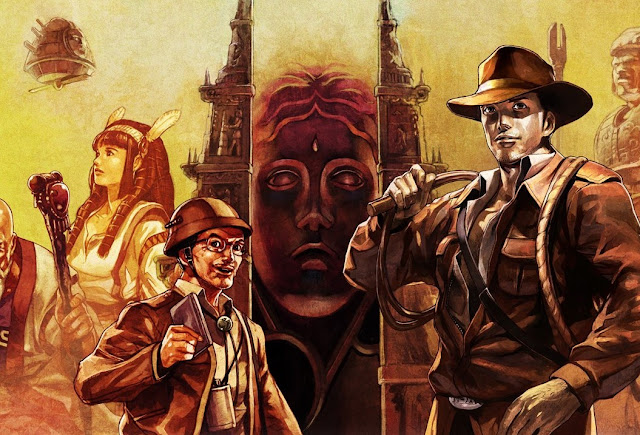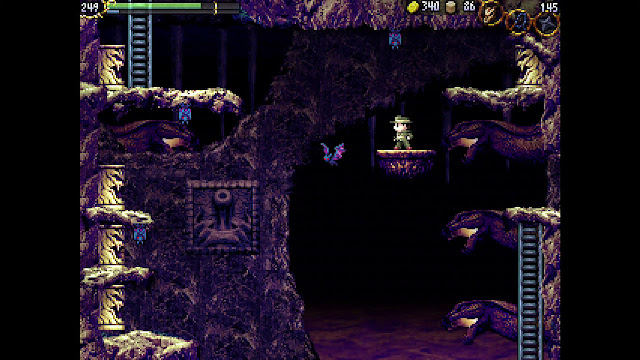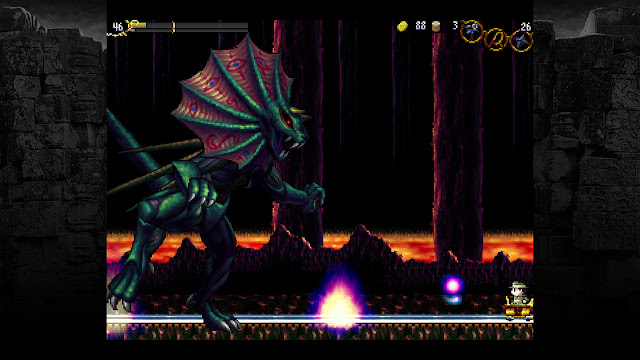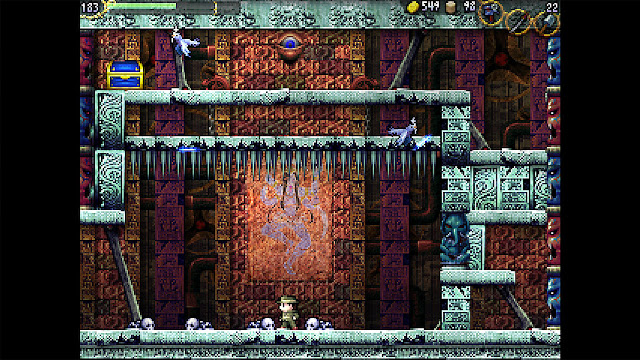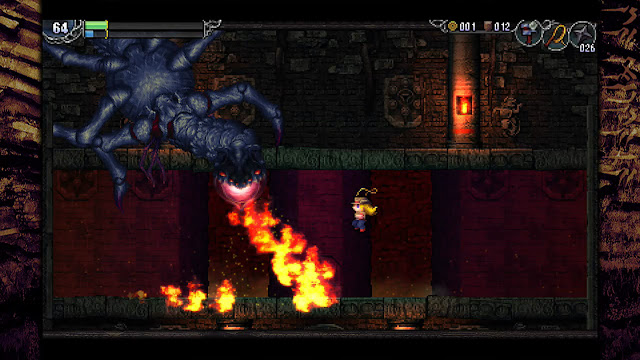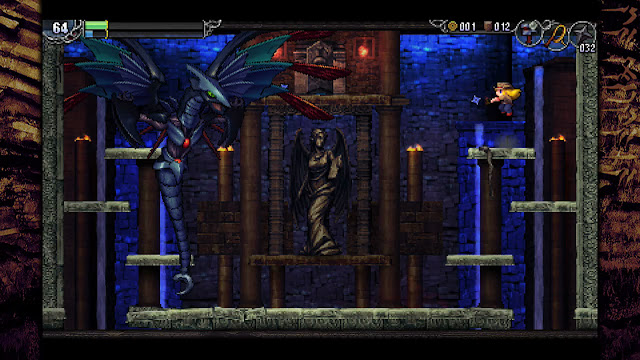Review by Harvard L.
I was only vaguely familiar with La Mulana when I first put on my Indiana Jones fedora and dived into the self-proclaimed Archaeological Ruin Exploration Action Game. As I did, I thought to myself “I’ve played a bunch of Metroidvanias before, what harm could one more do?” I’ve never been more satisfied, and more infuriated, to be wrong. La Mulana is deep. It’s a rabbit hole more complex and fiendish than anything else in its genre. It demands your dedication, whether through its challenging combat, demanding platforming or… puzzles.
I’ll talk about the puzzles later. I’m not ready for that yet.
I think the best way to describe La Mulana (and to shoo away both the people who would want to go in blind, and the people who really shouldn’t be buying this) is that there’s a burgeoning online cult following for this game, and they’re very particular about the messages they send to new fans.
Message 1: This game is demanding, challenging, and ultimately rewarding. (I’ve heard this one spoken about a lot of other games, so it didn’t deter me anywhere near as much as it should have.)
Message 2: Get a physical notebook. You’ll need it. (I’ve only ever done this for one game – Phantasy Star 2. I genuinely did not expect the sheer volume of information in La Mulana. I recommend the notebook. Grid paper if possible.)
Message 3: Guides and walkthroughs exist. You will probably feel the need to consult them. Use them as little as possible. (This is plastered on top of nearly every walkthrough for this game. I did used them liberally to get this review done on time, as spending three hours stuck on a puzzle wouldn’t exactly be productive. But all the walkthroughs seem to believe that the three hours of being stuck are part of the experience of La Mulana.)
If you’ve read those three messages and feel up to the task, let’s take a look at what this game is really about.
You play as Lemeza Kosugi, an Indiana Jones-esque archaeologist arriving to ransack the fabled La Mulana ruins, overseen by the Elder Xelpud, for fame and fortune. Armed with whip and fedora, Lemeza is very much an ordinary human being in a world populated by monsters and giants – once the protagonist figures out how to enter the ruins (a little easier said than done), you’ll start to feel the limitations your weak fleshy body provides when digging through these caves. This is conveyed even in the game’s controls: Lemeza’s jump will bring back nightmares of NES Castlevania titles where the second you’ve hit the jump button, you’re committed to your arc even if it means certain death. In La Mulana, hit boxes are small and jumps are short. There’s thankfully no fall damage but dropping from too great a height will punish the player with a humiliating, second-long splat animation, in which you’re very vulnerable. The absence of instant-death pits or spikes seems like a mercy at first, until you realise falling down a pit will send you far down enough that you’re incapable of jumping your way back up.
La Mulana takes this stilted, squishy protagonist and chucks him into one of the most labyrinthine 2D worlds of all time. To describe the game’s overworld as convoluted is an understatement. It is mind-bendingly complex. In addition to the ridiculous size, there are one-way pathways, hidden passages and rooms which inexplicably connect to each other in ways which should be geometrically impossible. The game’s map system is hilariously paltry in its ability to convey just how La Mulana operates. Hope you’ve got that notebook ready.
Before playing La Mulana, I thought I liked exploration in games. But after brute-forcing my way through a few of this this game’s zones, I realised that in fact, I don’t. I like it when games make me feel like I’m exploring an uncharted area, whilst an invisible hand leads me down a straightforward and infallibly linear path, and pats me patronisingly on the head for being so intrepid. La Mulana, though, is actual exploration. Scattered around the ruins are tablets in the game’s own invented language, traps in just the right moments that you’d expect a reward, and unceremonious death at the hands of zones far too strong for you to handle. La Mulana’s exploration feels all the more honest because it doesn’t stop you from going the wrong way, from getting lost, from screwing up. Watching Raiders of the Lost Ark is cool, but playing La Mulana is like first watching 99 other versions where Indy gets crushed by the boulder, before finally eking out his magnificent escape. It’s different. It changes you.
The version of La Mulana that most people are familiar with (whether from the WiiWare, PS Vita or Steam releases) is actually a remake of an original 2005 Japanese release – which boasts “modernised” graphics, fixed glitches as well as, shockingly, reduced difficulty. What we as the western audience miss out on is that La Mulana was originally a homage to the Japan-only MSX computer, the console which also birthed the very first Metal Gear game. In particular, La Mulana was inspired by Knightmare II: The Maze of Galious, which came out a year after (and feels like a real Frankenstein’s monster stitched together from) some more familiar games: The Legend of Zelda, Metroid, Kid Icarus and Castlevania. That alone might shed a little light on how Knightmare II, and thus La Mulana, handles exploration. Just like the original Legend of Zelda’s old-men-in-caves philosophy of breadcrumbing hints to the player, La Mulana’s in-game information remains obtuse, and demands some out-of-game effort in deciphering it.
And this brings us to the puzzles. Oh boy, the puzzles…
Puzzles in La Mulana are convoluted, non-linear, and require the devotion of a zealot to untangle solo. There is a burgeoning online community which handily drops hints in order to preserve that all-important moment of discovery, but its existence just proves the fact: this is going to be a tough game to get through alone. The leaps of logic, the amounts of pattern recognition, the deviations of standard game design practice – I don’t want to spoil any puzzle solutions in this review, but I do want to stress that puzzle-solving is by far the game’s most time consuming task, and that’s conceding that La Mulana has above average difficulty for both combat and platforming. Knowing where to go, what items to find and how to use them is going to test even the most dedicated of Metroidvania fans. You guys have been warned. Don’t approach this game lightly, lest you stumble halfway into the dungeon having missed a ton of crucial information, and having accidentally activated Hard Mode. (If a tablet tells you not to read it twice, DON’T READ IT TWICE.)
One positive aspect of all this complexity is that the game’s puzzles are intertwined by a game’s lore. Many interactions to unlock pathways deeper into the ruins are used as great opportunities to lay out the game’s backstory, and yep, La Mulana’s lore is a doozy. Weaving together elements of Mesopotamian religion, Gnosticism and good old-fashioned conspiracy theory, the complex plot is core to solving some of the more frustrating puzzles. It helps that the story is told in so many ways – through reading signs and skeletons, through observing surprisingly well-crafted background details, and through solving the puzzles. Many players have stumbled into these ruins planning to ignore the story, before quickly realising that they need to become an expert to advance: and it makes the exploration all the more worthwhile.
It’s a little similar to the way worldbuilding and lore was handled in Dark Souls… and yeah, let’s get that comparison out of the way. La Mulana came out well before FromSoftware codified what “game difficulty” meant, although both games clearly draw from the same era of design philosophy. (If one really wanted to, it wouldn’t be hard to trace the lineage from Knightmare 2 to the predecessor to Dark Souls, Kings Field.) Both games are hard in a textured manner; they use their difficulty to force a greater confidence in all the game’s mechanics. They’re also both very non-linear, although La Mulana more so – while you could technically sequence-break in Dark Souls 1, there’s not even really a sequence in La Mulana; it’s the equivalent of falling into a pit halfway through the Undead Asylum and waking up in Blighttown with no clothes. One’s a platformer and the other’s an action-RPG, but I feel like they’re both enjoyed in the same way, so yeah. If you like the feeling of Dark Souls you’ll probably like this.
La Mulana is an absolute behemoth of a game, and it’s an incredible achievement by a developer to craft the experience of true exploration, which puts just about any other adventure game to shame. It’s no surprise that this is a cult classic, and over time the active community has been welcoming new members, guiding newbies through the ruins and solving the deepest mysteries the game has to offer. But then some people started wanting the same thing, except more…
Which brings us to…
La Mulana 2
Let’s start this on the right foot: nothing in La Mulana 1 was unintentional, nothing in La Mulana 1 was a mistake. Everything good and bad about the first game is, in some way, present in the second. So if you’re not at all interested in the first, there’s no way the second is going to swing your opinion.
La Mulana 2 is, at first, a big joke. The original developers argued that they would never make a sequel to the first La Mulana, and then a few years later a Kickstarter appeared from NIGORO. It’s a labour of love but it’s also a game made in full knowledge of the first title’s reputation, and it’s kind of impossible to make a straight-faced sequel when up against that kind of pressure. That being said, La Mulana 2 is tremendously successful as a sequel: what starts out as a tongue-in-cheek parody of the first game suddenly bulks up into a behemoth just as formidable as the first.
Whereas the original La Mulana was unforgivingly obtuse, the sequel is playfully obtuse. The difference is that La Mulana 2 still stonewalls the player with impossibly difficult combat encounters and puzzles, but it also laughs at the player (and occasionally itself) once this happens. It’s an oddly affirming experience, to know that the game knows that it is hard. Progressing in La Mulana 2 often feels mirthful, and maybe even uplifting, coupled with the customary sigh of “thank God that’s over” and “finally the Shell Horn sound, I’ve been waiting for that damn toot for hours.”
There’s a far more pronounced humour in La Mulana 2, which is compounded if you’re a connoisseur of the original. For example, the early NPC who sold you weights and a map in the first game reappears. In La Mulana 1, her eyes would glow menacingly red if you left without buying anything. In La Mulana 2 she’s now carrying a baby who laughs as she yells at you, and I quote, “Hey dicknuts! I just SAID you’re gonna NEED that thing, didn’t I? So BUY that shit! You want me to get WEIRD on your ass?!”
This is to say that many of the missable things in La Mulana 1 are conspicuously less missable in La Mulana 2. Items like the Shell Horn and the Holy Grail, which in any other game would be in the player’s inventory from the get go, appear as large chests with nearby diases compared to the first game, in which clues needed to be followed in order to unlock them. The Holy Grail especially, which allows for instant free teleportation to save points, is an absolute must in both games – and after realising I’d spent a few hours in the original fumbling around dungeons without it, I made a foolhardy assumption that La Mulana 2 was going to be a more forgiving adventure.
Lots of things in La Mulana 2 feel more “refined” and sanded down from the original’s harsh MSX verisimilitude. The sequel is certainly not modern by any standards (you’d be hard pressed to find any other game released in 2019 which so convincingly feels like it first came out in 1991) but it’s also less abrasive than the first. For example, jumping doesn’t lock you into the Castlevania-like arc, but you can control your in-air movement a little (like in Super Castlevania IV). You can also jump onto and off ladders as well. When you start up La Mulana 2 after finishing the first – it feels the way you remember the first game feeling, whilst if you were to finish the second before playing the first, the absence of the sequel’s quality-of-life changes would make the original near unplayable.
NIGORO planned for La Mulana 2 to appeal to both veterans and newcomers of the series, but I would still highly recommend starting with the first. One reason is because of those crucial quality-of-life upgrades, but also the lore of the second game very much builds upon the foundations of the original. In La Mulana 2, the player takes the role of Lumisa Kosugi, the daughter of the original’s Lemeza. In the years since the events of the first game, Xelpud has turned the La Mulana ruins into a tourist trap, but the resurgence of monsters has driven away the customers. So Xelpud requests for Lemeza to come back and lay down a beating, but Lumisa appears instead. In her quest to find Lemeza, she bumbles into Eg-Lana: another set of dungeons which serve as a dark counterpart to La Mulana, and shed a different light on the lore of the first game. La Mulana 2 continues the first game’s ethos of a giant, game-long myth arc where all Creation legends are true and there’s a big mishmash of Mesopotamian, Eastern, Celtic and whatever other pantheon you can think of. This time around, there’s a better focus on characterisation, with more people to interact with, and more often. NPC’s will change their regard to you and the events as the plot develops, and this goes a great length to giving the story more weight. In La Mulana 1, you were largely piecing together events that had already happened, and making sense of what was, in essence, history. Meanwhile in La Mulana 2, things are kinetic, changes are happening, and your actions have a greater impact on the lore itself.
So to make this narrative possible, La Mulana 2 spoils the events of the first game early and often. It’s a shame, because the original has a few well-kept secrets, even in the internet age, thanks to the community’s insistence that each player pieces the lore together on their own. So I would say that only for people who have no real intention of playing La Mulana 1 should start with the sequel; otherwise, it’ll be best to go in order.
And for veterans who perhaps thought the sequel would have a dumbed-down difficulty to appease newcomers, you’ll realise early on that this is not the case. La Mulana 2 is every bit as hard and complex as the first. (As of writing this, a recent balance patch adjusted the difficulty of some late-game bosses, because veterans were complaining they were too easy.) For those deeply invested in the first game, La Mulana 2 should serve as a huge relief. It retains the same teeth and thick hide, and it even expands on some plot threads that were left dangling in the original.
One thing I noticed more in the sequel was that enemy designs were downright annoying. Bats, which were prevalent in both games, have an infuriating flight path in the second that will certainly tax some health off reckless adventurers. It made me realise that the room to room combat in both was largely to impediment players in their search for the puzzle’s solution; the enemies weren’t the challenge themselves. This is perhaps the best summation of La Mulana’s difficulty: it tests the player’s patience and attentiveness, and most of the battle happens outside the game. Enemies and bosses are not so easily beaten by skill as they are by long-term strategy. Whereas most players will leave other Metroidvanias with a good exercise in their spatial awareness and twitch reflexes, La Mulana sharpens knowledge.
Also, once nice thing that didn’t fit well into the structure of this review was that La Mulana 2 has exceptionally good art. NPCs are all illustrated full-body this time around, and emote a lot better than their original incarnations. Lumisa also has a lot of interesting animations which belie a huge amount of effort to tie it all together. The visual distinctiveness of the dungeon sections also returns here, with even more fidelity: no two rooms look alike, background elements are fantastic memory-anchors and when a trap activates, you’ll know it clearly. There are some sneaky uses of 3D here too which work very well to bring the vision to life. But this isn’t a game about stopping to smell the roses; I don’t recommend anyone play this solely for the art.
One thing to be aware of in the second game is that there are a few lategame bugs which can impede progress; naturally with a game of this size and scope some things are bound to slip through. The Switch version is constantly being patched along with the Steam and other console versions, so any nasty surprises will surely find their way out with time.
La Mulana 2 may just be more of the same, but it’s also a home run for a winning formula that nobody else is making nowadays. For players who enjoy complexity and depth, there’s an ocean of possibility here which makes any other Metroidvania look like a puddle by comparison. (Yeah, even Hollow Knight.) It’s humbling for a game to show me what it really feels like to not have my hand held at all: it forced me to swallow my pride, grab a pen and paper, and earn my progress forward. Few games can boast that. And once you’ve braved the ruins of La Mulana, you can bravely look to the future with confidence. Because you’re an archaeologist now.
– Harvard L.
Contributor
A copy of this game was provided by the publisher for review.

